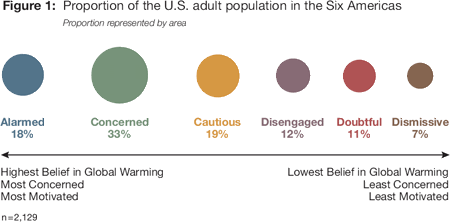Researchers at George Mason University and Yale broke down U.S. public opinion into six different categories [pdf], based on people’s belief in, and concern about, global warming.
For the nickel version, see the graphic below:

Of course, I’m sure there are more than six ways of slicing this pie. It seems likely to me that public opinion lies in a continuum, rather than in six discrete groups.
Still, the authors’ analysis yields some interesting findings. My favorite is this: folks who are convinced that global warming is a hoax — the “Dismissives” — admit they haven’t thought all that much about the issue (see Figure 6 on page 14 of the pdf) yet rank themselves as extremely knowledgeable and well informed (see Figure 7).
That should tell us something: for many climate skeptics, facts don’t matter much. They’ve only given the subject a bit of thought, but are still convinced that they know the answers. I don’t mean to be snarky, but to me this suggests that some “Dismissives” may suffer from some version of the Dunning-Kruger effect — the idea that people are very poor judges of their own incompetence. That probably makes many “Dismissives” unreachable: when facts confront their biases, the facts bounce off and the biases stand firm. (I’m sure that’s true of us all, to some degree or another.)
And here’s another point: press accounts of climate issues often include spokespeople at the poles; reporters balance quotes from the “Alarmed” with quotes from the “Dismissive.” Yet the “Six Americas” report suggests that the process of “balancing” reporting by providing quotes and perspectives from both sides of the debate gives a skewed representation of public opinion. The “alarmed” and “concerned” make up about 51 percent of the population, while the “doubtful” and “dismissive” represent 18 percent. Yet if you look at standard he-said-she-said reporting, you might think that opinion is roughly split down the middle.
I’d be very interested in seeing this analysis applied to actual climate scientists. After all, the question of whether climate change is a real threat can’t be decided by a popularity contest or a public opinion poll; the debate is over facts, not opinions. Many of the climate scientists I’ve met fall into some sort of category far beyond Alarmed — like “Super-Duper-Mega-Alarmed” — and one has fallen somewhere between Cautious and Doubtful (though certainly not Disengaged). The closest thing we have to this kind of weighing of the collective opinions of professional climate scientists is the IPCC report — essentially, a survey of the opinions of the super-informed. And contrary to the scorn of the Dismissives, that report leaves little doubt about where the scientific consensus falls. From the that report:
Most of the observed increase in global average temperatures since the mid-20th century is very likely due to the observed increase in anthropogenic GHG concentrations.
I’d think that sort of statement would be hard to dismiss; but apparently, that’s just my opinion.
This post originally appeared at Sightline’s Daily Score blog.

